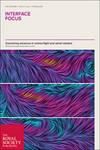Stiff morphing composite beams inspired from fish fins
IF 3.6
3区 生物学
Q1 BIOLOGY
引用次数: 2
Abstract
Morphing materials are typically either very compliant to achieve large shape changes or very stiff but with small shape changes that require large actuation forces. Interestingly, fish fins overcome these limitations: fish fins do not contain muscles, yet they can change the shape of their fins with high precision and speed while producing large hydrodynamic forces without collapsing. Here, we present a ‘stiff’ morphing beam inspired from the individual rays in natural fish fins. These synthetic rays are made of acrylic (PMMA) outer beams (‘hemitrichs’) connected with rubber ligaments which are 3–4 orders of magnitude more compliant. Combinations of experiments and models of these synthetic rays show strong nonlinear geometrical effects: the ligaments are ‘mechanically invisible’ at small deformations, but they delay buckling and improve the stability of the ray at large deformations. We use the models and experiments to explore designs with variable ligament densities, and we generate design guidelines for optimum morphing shape (captured using the first moment of curvature), that capture the trade-offs between morphing compliance (ease of morphing the structure) and flexural stiffness. The design guidelines proposed here can help the development of stiff morphing bioinspired structures for a variety of applications in aerospace, biomedicine or robotics.从鱼鳍中汲取灵感的刚性变形复合梁
变形材料通常要么非常顺从以实现较大的形状变化,要么非常坚硬但形状变化较小,需要较大的驱动力。有趣的是,鱼鳍克服了这些限制:鱼鳍不含肌肉,但却能高精度、高速地改变鳍的形状,同时产生巨大的流体动力而不会塌陷。在这里,我们展示了一种 "坚硬 "的变形梁,其灵感来自于天然鱼鳍中的单个鱼鳍。这些合成鱼鳍由丙烯酸(PMMA)外梁("hemitrichs")和橡胶韧带连接而成,橡胶韧带的顺应性要高出 3-4 个数量级。这些合成射线的实验和模型组合显示出强烈的非线性几何效应:韧带在小变形时是 "机械隐形 "的,但在大变形时却能延迟屈曲并提高射线的稳定性。我们利用模型和实验来探索韧带密度可变的设计,并为最佳变形形状(使用第一曲率矩捕捉)生成设计指南,该指南捕捉了变形顺应性(结构变形的难易程度)和弯曲刚度之间的权衡。本文提出的设计准则有助于开发刚度变形生物启发结构,可广泛应用于航空航天、生物医学或机器人领域。
本文章由计算机程序翻译,如有差异,请以英文原文为准。
求助全文
约1分钟内获得全文
求助全文
来源期刊

Interface Focus
BIOLOGY-
CiteScore
9.20
自引率
0.00%
发文量
44
审稿时长
6-12 weeks
期刊介绍:
Each Interface Focus themed issue is devoted to a particular subject at the interface of the physical and life sciences. Formed of high-quality articles, they aim to facilitate cross-disciplinary research across this traditional divide by acting as a forum accessible to all. Topics may be newly emerging areas of research or dynamic aspects of more established fields. Organisers of each Interface Focus are strongly encouraged to contextualise the journal within their chosen subject.
文献相关原料
| 公司名称 | 产品信息 | 采购帮参考价格 |
|---|
 求助内容:
求助内容: 应助结果提醒方式:
应助结果提醒方式:


